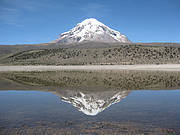IUCN’s Red List of Ecosystems gains speed
09 September 2012 | International news release
From Australia to Patagonia, from coral reefs to rainforests and deserts, the new IUCN Red List of Ecosystems will assess the status of ecosystems worldwide, to identify their risks and the potential impact on both ecosystems and human wellbeing.
Modelled on the influential IUCN Red List of Threatened Species™, the Red List of Ecosystems will identify if an ecosystem is vulnerable, endangered, or critically endangered, based on an agreed and internationally accepted set of criteria for risk assessment. In addition to providing a global standard for assessing the status of ecosystems, the outputs of the Ecosystem Red List could also be used to inform on the current and future threats to the services that such ecosystems provide, such as clean water, climate regulation and natural products.
“Natural environments are under increasing pressure from unsustainable use and other threats,” says Jon Paul Rodriguez, Leader of the IUCN Commission on Ecosystem Management’s Ecosystems Red List Thematic Group. “Functional ecosystems are essential to our livelihoods and wellbeing. We will assess the status of marine, terrestrial, freshwater and subterranean ecosystems at local, regional and global levels. This, in turn, will help inform on the link between such systems and the livelihoods of those who depend on them. The assessment can then form the basis for concerted implementation action, so that we can manage them sustainably if their risk of collapse is low, or restore them if they are threatened and then monitor their recovery.”
The Red List of Ecosystems can help guide conservation action on the ground, including land use planning and investment priorities, by evaluating the risks of ecosystem collapse and the subsequent lost of ecosystem services. This can be a basis for landscape and economic analysis, which then forms the basis for action, leading, for example, to ecosystem restoration and improved governance.
“We envision that it could become a one-stop shop for economists, rural communities, local and national authorities, who can use the assessments of the Red List of Ecosystems to better manage the finite resources of our planet,” says Edmund Barrow, Head of the IUCN Ecosystem Management Programme.
According to IUCN, the Red List of Ecosystems will also influence the policy process of international conventions, such as the Convention on Biological Diversity and guide investments for several Millennium Development Goals, such as poverty reduction and improvements in health—both dependent on healthy natural environments that provide important goods and services for human wellbeing.
The process for establishing an IUCN Red List of Ecosystems was launched at IUCN’s World Conservation Congress in 2008 and since then the IUCN Commission on Ecosystem Management has focused on consolidating assessment criteria for categorizing ecosystems according to their risk of collapse and piloting this in different countries, such as Venezuela and Senegal. Though the process for assessing the world’s ecosystems is ongoing, and regional assessments will be published as they become available, complete global coverage of all of Earth’s marine, terrestrial, freshwater and subterranean ecosystems is planned for 2025.
For more information or to set up interviews, please contact:
Borjana Pervan, IUCN Media Relations, m +82 10 2150 7308, m +41 79 857 40 72, email borjana.pervan@iucn.org
Maggie Roth, IUCN Media Relations, m +82 10 2150 8732, m +41 79 104 2460, email maggie.roth@iucn.org



